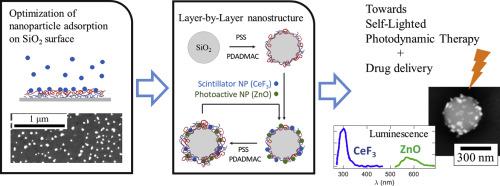Colloid and Interface Science Communications ( IF 4.5 ) Pub Date : 2020-10-24 , DOI: 10.1016/j.colcom.2020.100327 Davide Orsi , Davide Bernardi , Guglielmo Giovanardi , Francesca Rossi , Krzysztof Szczepanowicz , Luigi Cristofolini

|
X-ray induced Photodynamic Therapy (XPDT) is a proposed therapy for deep tumours. The idea is to use the X-ray beam of a standard radiotherapy facility to excite a scintillator which is coupled with a photosensitizing agent which in turn generates reactive oxygen species (ROS) which induce local oxidative stress. Alike in standard Photodynamic Therapy, this oxidative stress may be used to treat tumours. Preliminary results [F. Rossi et al. Sci. Rep. 5 (2015) 7606] demonstrated that can XPDT enhance the efficacy of standard radiotherapy, while reducing its unwanted side effects.
This work reports the rationale development of a nanostructure incorporating nanoparticles (NP) for XPDT around a silica core by means of electrostatic adsorption. To this aim, scintillator CeF3 and photosensitizer ZnO, both in form of nanoparticles, have been adsorbed into a polyelectrolyte Layer-by-Layer (LbL) multilayer grown around a SiO2 core. This structure, in a future work, could be a platform for drug delivery.
We optimized the growth of the structure basing on results from adsorption on planar substrates, as a function of incubation time, of particle concentration, and of the composition of the outer polyelectrolyte layer, having also in mind the need to avoid the formation of micrometric aggregates. This drove the rationale synthesis of the nanocapsules. The resulting structures are studied by Scanning Electron Microscopy, X-ray Microanalysis, Dynamic Light Scattering, and ζ-potential analysis.
中文翻译:

X射线诱导的光动力疗法的逐层纳米结构的原理设计
X射线诱导的光动力疗法(XPDT)是针对深部肿瘤提出的一种疗法。这个想法是使用标准放射治疗设备的X射线束激发闪烁体,该闪烁体与光敏剂耦合在一起,而光敏剂又会产生引起局部氧化应激的活性氧(ROS)。与标准的光动力疗法一样,这种氧化应激也可用于治疗肿瘤。初步结果[ F. Rossi等。科学 Rep。5(2015)7606]证明XPDT可以增强标准放射疗法的功效,同时减少其不良副作用。
这项工作报告了通过静电吸附在二氧化硅核周围掺入XPDT纳米粒子(NP)的纳米结构的原理发展。为此,闪烁体CeF 3和光敏剂ZnO均以纳米颗粒的形式被吸收到围绕SiO 2核生长的聚电解质层(LbL)多层中。在将来的工作中,这种结构可以成为药物输送的平台。
我们根据在平面基板上的吸附结果(取决于孵育时间,颗粒浓度和外部聚电解质层的组成)来优化结构的生长,同时还需要避免形成微米级聚集体。这推动了纳米胶囊的基本合成。通过扫描电子显微镜,X射线显微分析,动态光散射和ζ电位分析研究所得结构。



























 京公网安备 11010802027423号
京公网安备 11010802027423号